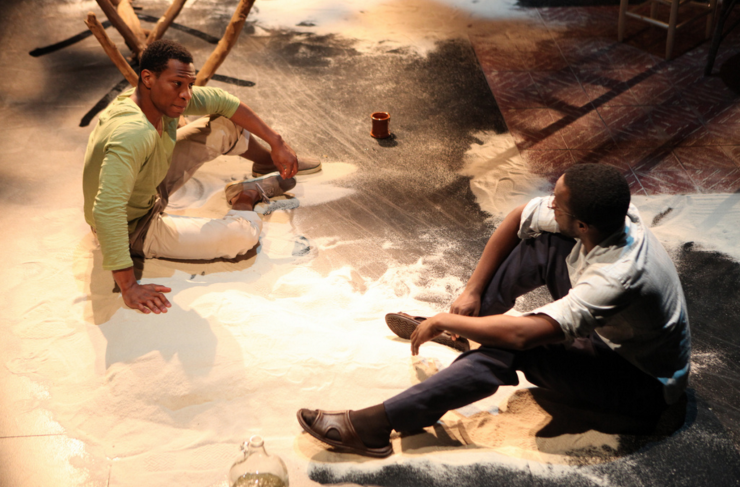Cry Old Kingdom
Most mainstream audience members in the United States know little of the oppressive political history of Haiti and the horrors of the “Papa Doc” and “Baby Doc” Duvalier dictatorships stretching from the late 1950s through the mid 1980s. Jeff Augustin’s Cry Old Kingdom, which played through April 7 at the Actors Theatre of Louisville as part of the Humana Festival of New American Plays, teaches the audience of the misery of this history, illustrating the chasm between the country in which it is performed—the richest in the world—and the one in which it is set—the poorest in the Western hemisphere. Tom Dugdale’s intimate staging in the round enabled the predominantly white, middle class Humana Festival audience to watch each other watch the plight of a dissident painter trying to survive in Haiti in 1964 during the repressive “Papa Doc” Duvalier regime.
The white sand of Haiti spills out of the VOMs of the Bingham Theatre onto a tile floor that peels back like a cresting wave, showing entering audience members the layers of rock and corrugated metal that lie beneath. The view appears quite different to audience members sitting in different parts of the theater. Just as audience members may have access to different views of this world, so do the characters inhabiting it.

Edwin (Andy Lucien), a painter, has been “officially dead for years.” He and his wife Judith (Natalie Paul) have been in hiding in a remote village. Edwin has been spending his days beginning paintings he cannot finish in the solitude of his underground studio. In the opening moments of the play, Edwin finds inspiration in Henri (Jonathan Majors), a beautiful but scarred young man he meets on a beach, gathering bleached deadwood on scenic designer Daniel Zimmerman’s bleak, tropical set. Henri gathers wood to build a boat, intent on escaping a mysterious past, Papa Doc’s regime, and the Tonton Macoutes death squads. Edwin is captivated, and offers a trade: Henri can build his boat in the safety of Edwin’s studio if Edwin can paint him in the process. The men develop their friendship underground, away from the eyes of the Duvalier regime that would punish both.
Edwin is a political casualty—his paintings are not explicitly political, yet they hang in the “wrong houses.” He is, at best, an accidental dissident, and while he is clearly miserable in exile, he bears his “death” quietly. At the center of the play is the question of where his loyalties should and do lie as he struggles to find life in his “death.” Through the play, Edwin chooses what he is willing to sacrifice, and then deals with the ramifications of those choices. His story operates on two levels: the impact of his actions and inactions plays out in the private sphere of his personal life while the audience is made painfully aware of the wider political ramifications of these actions and inactions as he at times resists, and at times, reinforces an oppressive regime. In his choices, the play asks its privileged audience members the question, “what would you be willing to sacrifice?”
Edwin’s wife, Judith, has sacrificed her life in the city with the vibrant community of intellectuals she and Edwin belonged to prior to Papa Doc’s rise to power. She attempts to steal moments of pleasure, squeezing what joy she can out of her work under the hot sun of the open market. However, it is the promise of coming revolution that quickens her pulse. Edwin has stopped wanting to touch her after “her body betrayed her” with multiple miscarriages. To compensate, she focuses on any fleeting memory of pleasure that can help her remember what it is to feel alive—dancing at Carnival, eating ice cream, and most powerfully, the promise of revolution. As rumors of a new revolution brew, she devours them, fleeing the coldness of her marriage bed for the heat of political protest. By the end of the play, Papa Doc’s regime has swallowed her whole, stripping her of her vivacity and leaving her a mere shell of her former self. If Edwin is “officially dead,” the audience watches Judith wither before our eyes.
Edwin and Henri’s friendship develops under the gaze of the audience, who watches eroticism simmer beneath the surface of the relationship, as Lorraine Venberg costumes Henri’s supple body in a fitted, almost sheer tee shirt that ripples with his every move. When he does, ultimately, remove the yellow shirt, a lattice of pale scars covers his broad cocoa-colored back. The horror of the story he tells of the source of these scars does not diminish the eroticism of the moment; the spectacle of his body overshadows the legacy of political violence he describes. The Tonton Macoutes death squads made his body into a weapon; violence was inflicted upon him as he was made to inflict violence himself.
Under Edwin’s objectifying gaze, Henri’s body still exists to be used by others.
In this moment, I was particularly aware of the historic power dynamics embedded in the actor-audience relationship throughout the piece
This message was perhaps unintentionally underscored by a moment in the post-performance talkback I attended, in which an audience member asked actor Jonathan Majors if he would take off his shirt again. This audience member viewed the actor’s body, like his character’s body, to exist for the pleasure and/or utility of others. In this moment, I was particularly aware of the historic power dynamics embedded in the actor-audience relationship throughout the piece, as privileged, mostly white, American spectators surrounded the Haitian characters, quietly looking down on them from their raised seats. Though the performance was over, this particular older, white audience member believed the price of admission included continuing power over the body of this young, black actor.
Just prior to the climax of the play, Henri sits on a railing, inches from a row of white, middle-aged, middle class looking audience members. He looks out over a section of the audience, searching for the compatriots with whom he intends to cross the ocean to the United States in his newly constructed boat. The remainder of the audience sees this young black man looking out over a sea of white faces—the America of his hope and dreams—which is both so physically close to him and yet so very far away. We hope he will make it, yet we know he probably will not. The audience members sit quietly, watching, doing nothing, a powerful representation of the apathy of the nation on which Henri has pinned his hopes.








Comments
The article is just the start of the conversation—we want to know what you think about this subject, too! HowlRound is a space for knowledge-sharing, and we welcome spirited, thoughtful, and on-topic dialogue. Find our full comments policy here
wow. I saw this production. I find your review almost as beautiful and breathtaking as the play.
I enjoyed reading your comments, finding them thought provoking and interesting. I would have liked to have seen the production.